How to Make Elderberry Syrup with Fresh or Dried Berries
This post may contain affiliate links. Read my full disclosure here.
In this post we’ll share how to make elderberry syrup with fresh or dried berries or juice. Making your own is a great way to save money on this wonderful immune supporting tonic. It’s great for kids and adults during cold and flu season.
I noticed years ago that the ingredient lists on most commercial elderberry syrups for kids don’t contain much elderberry. Now we make our own so we know it’s the real deal.
Studies have shown that elderberry syrup helps treat the flu virus. (See more information on those studies at the end of the post.)
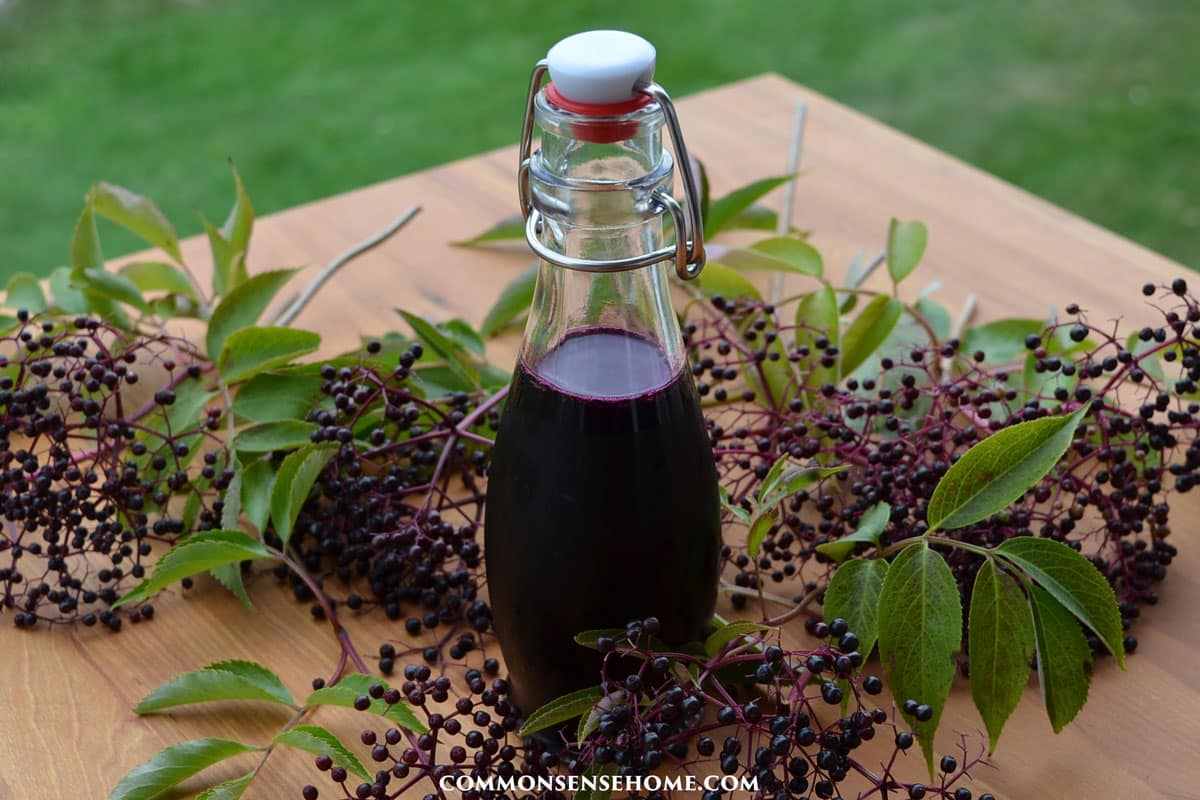
Table of Contents
- How to Use Elderberry Syrup
- Elderberry Syrup Recipes
- How to Make Juice from Fresh Elderberries to use for your Syrup
- Harvesting Elderberries
- If You Don’t Have Access to Elderberry Bushes
- Pick the Right Cinnamon!
- Storing Homemade Elderberry Syrup
- Is it Safe to Can Elderberries?
- Health Benefits of Elderberries
- Is Elderberry Syrup Effective Against the Flu?
- Can dried elderberries be reused to make two batches of syrup?
- More Elderberry Recipes
How to Use Elderberry Syrup
To use elderberry syrup as a preventative, give a tablespoon per day to adults or a teaspoon per day to children.
At the first sign of illness, give adults a tablespoon full every 2-3 hours. For children, give a teaspoonful every 2-3 hours.
Elderberry Syrup Recipes
We have two recipes – one made with dried berries, the other made with juice.
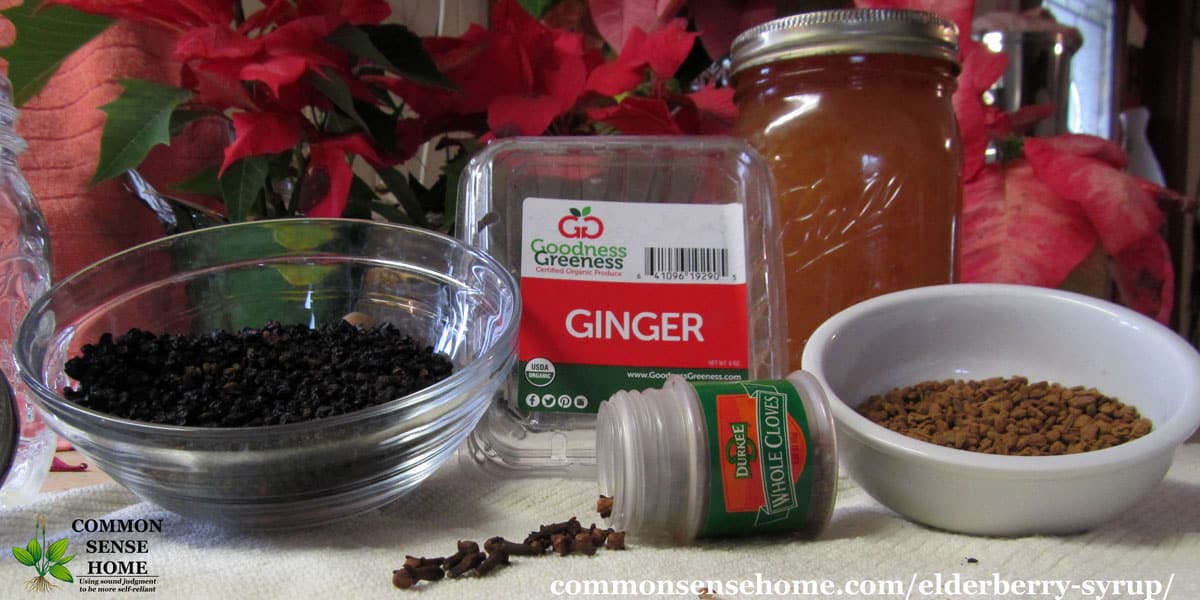
Elderberry Syrup Recipe Using Dried Elderberries
Easy elderberry syrup recipe made with soothing herbs, honey and dried berries.
- Prep Time: 5 minutes
- Cook Time: 20 minutes
- Total Time: 25 minutes
- Yield: 2 cups 1x
- Category: Condiment
- Method: Stovetop Cooking
- Cuisine: American
Ingredients
- 1/2 cup dried organic Elderberries (4 ounces)
- 2 cups water
- 1 cup raw honey
- 1 organic cinnamon stick
- 5 organic cloves
- 1 Tablespoon freshly grated ginger or a pinch of dried organic Ginger root (optional)
Instructions
- Place berries, water, and spices in a saucepan.
- Bring to a boil, reduce heat, and simmer for 20-30 minutes, until liquid is reduce by one half.
- Strain the mixture into a bowl, squishing juice out of the berries.
- Stir in honey. Allow to cool and stored in a sealed jar in the refrigerator.
Notes
This will last for 3 weeks or more stored in the refrigerator. You can freeze for longer storage to keep the honey raw. Freeze in ice cube trays if you would like to take out small amounts as needed.
Note: To preserve all the benefits of your raw local honey, make sure to heat the syrup gently. Do not bring to a boil.

How to Make Juice from Fresh Elderberries to use for your Syrup
Strip the berries from the stem and rinse off any debris. You can use a steam juicer to make elderberry juice, or cook the berries down on the stove top and strain.
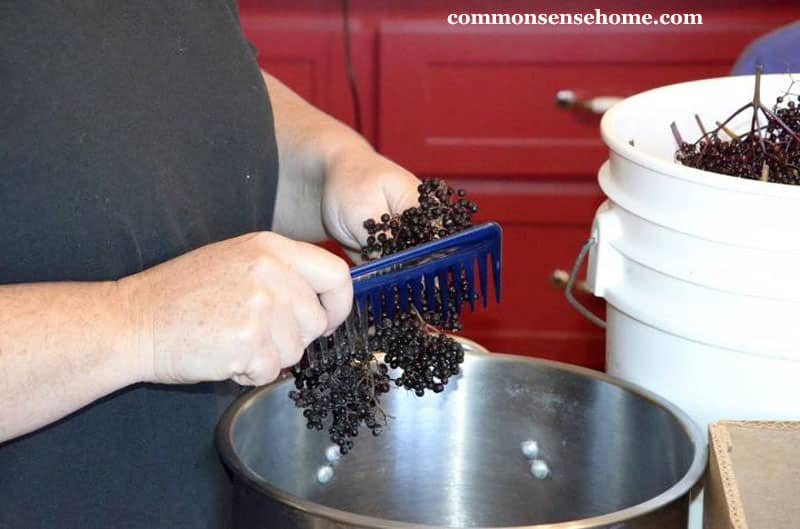
Do not use mechanical juicers that leave the berries raw. Heat deactivates the cyanogenic glycosides and alkaloids in the elderberries, which makes them safe to consume.
To make elderberry juice on the stove top, first remove your berries from the stems. I load my berries into a heavy bottom pot to prevent scorching, then mash them with a potato masher and add about 1/4 inch of water.
Simmer, stirring regularly, until soft and mushy, about 30 minutes. Press the cooked berry mixture through a fine mesh strainer lined with cheesecloth. (You can also use an old t-shirt, towel, or pillowcase to line the strainer. The cloth will get stained.)
Let the berries drain until juice stops dripping, usually several hours or overnight. Discard the skins and stems and use the juice for syrup or jelly.
PrintElderberry Syrup Recipe with Lemon and Cloves
Elderberry, lemon and cloves combine for a gentle syrup for colds and coughs.
- Prep Time: 10 minutes
- Cook Time: 10 minutes
- Total Time: 20 minutes
- Yield: 3–4 cups 1x
- Category: Condiment
- Method: Canning
- Cuisine: American
Ingredients
- 1 pint elderberry juice
- 1lb (450g) of sugar
- Juice of one lemon
- 10 whole cloves
Instructions
- Sterilize two 16-ounce jars or four 8-ounce jars, keep hot. Heat lids and rings in hot water, keep warm but not boiling. Fill water bath canner and bring to boil.
- Combine all ingredients in a large, non-reactive pot. Heat and stir until all sugar is dissolved. Bring to boil and boil for ten minutes (this infuses the flavor of the spices into the syrup).
- Strain out cloves and ladle hot syrup into sterilized jars leaving 1/4″ headspace. Wipe rims clean and screw on the lids.
- Process for 10 minutes in water bath canner (add 1 minute for every 1,000 feet above sea level). Makes around 1-2 pints (3-4 cups) of syrup.
Notes
Adapted from Ashridge Trees in the UK.
Elderberry Syrup with Honey and Cinnamon
Elderberry, cinnamon and honey combine for this soothing elderberry syrup for kids.
- Prep Time: 10 minutes
- Cook Time: 10 minutes
- Total Time: 20 minutes
- Yield: 3 pints 1x
Ingredients
- 1 quart elderberry juice
- 2 cups honey
- 2 sticks cinnamon
- 1/4 cup lemon juice or 1 tablespoon citric acid* – if canning
Instructions
- Sterilize three 16-ounce jars, keep hot. Heat lids and rings in hot water, keep warm but not boiling. Fill water bath canner and bring to boil.
- Combine all ingredients in a non-reactive pot. Heat and stir until all honey is dissolved.
- Simmer for ten minutes. (This infuses the flavor of the spices into the syrup.)
- Ladle hot syrup into sterilized jars leaving 1/4″ headspace. Wipe rims clean and screw on the lids.
- Process for 10 minutes in water bath canner (add 1 minute for every 1,000 feet above sea level). Makes around 3 pints of syrup
Notes
To keep the honey raw, don’t can the syrup, refrigerate instead.
To prepare and keep the honey raw, simply simmer the elderberry juice and cinnamon sticks together for 10-20 minutes. Remove from heat and let cool to lukewarm. Stir in honey until dissolved.
Store in the refrigerator and use within a month or so or freeze for longer storage. Oversized ice cube trays work well.

Harvesting Elderberries
The first time I made elderberry syrup, my friend, Tami, harvested and processed a ton of berries into juice. She brought juice over later in the week, and we set to work making syrup and jam.
Elderberries grow on large shrubs that like plenty of moisture. The American black elderberry is native the eastern United States.
You may be able to find it in the wild, but make sure you have a positive ID before harvesting. You can see the plants and tips for identification here.
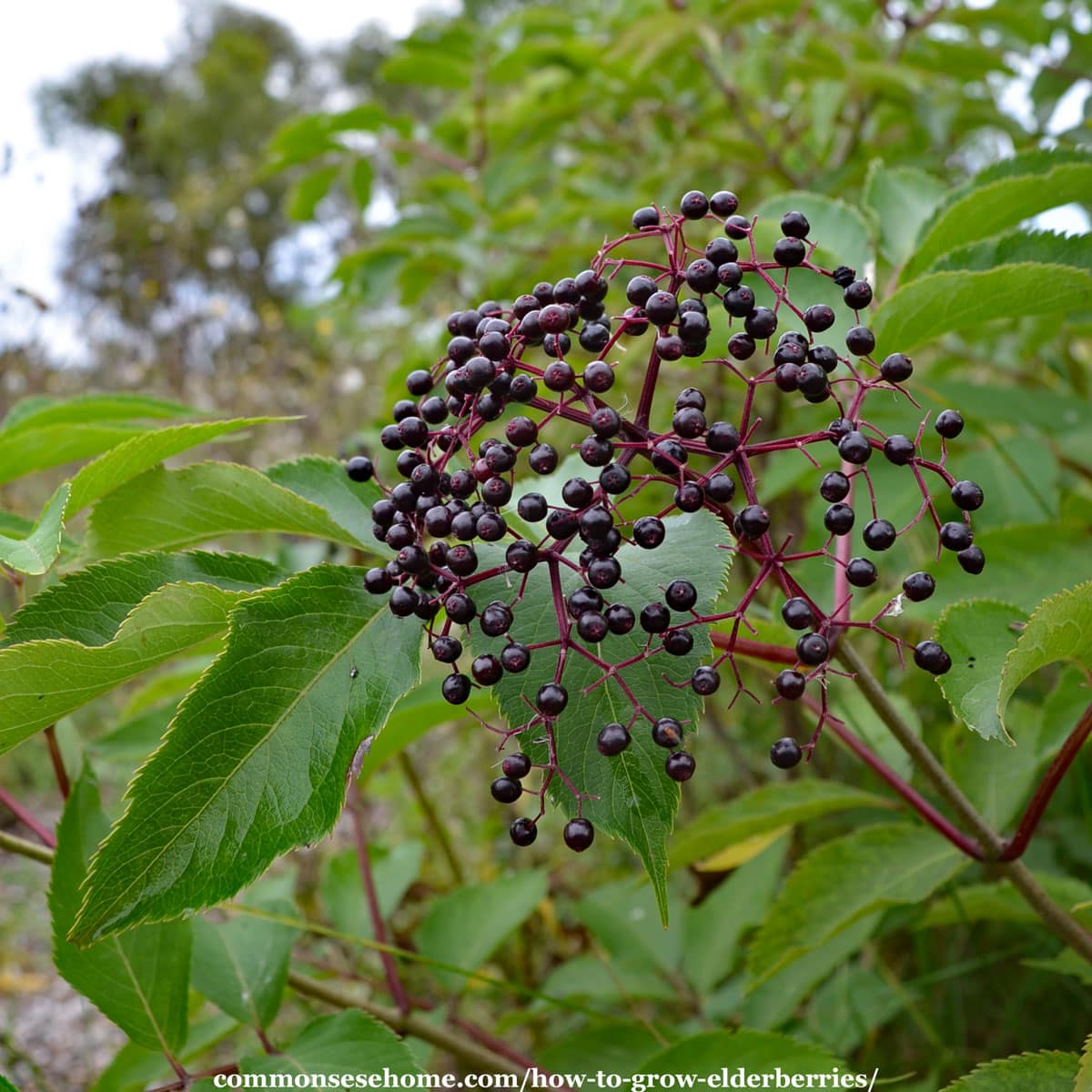
Elderberry bushes are also available through nurseries, so you can grow your own. We have a large elderberry patch planted at the north edge of our yard.
Learn how to grow elderberries here.
If You Don’t Have Access to Elderberry Bushes
Making elderberry syrup from dried elderberries is cheapest, but the juice based syrups have a little more berry flavor.
Wyldewood Cellars elderberry concentrate is made with pure elderberry juice and water. (Most products contain other juice or additives.)
Gaia Herbs Black Elderberry Syrup is USDA certified organic elderberry syrup, and is made with:
- Organic Black Elderberry
- Organic Acerola fruit
- Vitamin C (from Organic Acerola)
- Organic cane sugar
- water
- lemon juice
Pick the Right Cinnamon!
Note: Ceylon cinnamon (Cinnamomum zeylanicum or Cinnamomum verum – true cinnamon ) has better medicinal qualities than cassia cinnamon (Cinnamomom cassia).
I usually buy my Ceylon cinnamon sticks in bulk to save money and split the purchase with friends. I store any unused cinnamon sticks in a vacuum sealed mason jar to keep them fresh.
Would you like to save this?
Storing Homemade Elderberry Syrup
Can your elderberry syrup to store at room temperature, or keep it refrigerated or frozen. It should last for 3 weeks or more when refrigerated.
For longer storage, canning or freezing is recommended. Use an ice cube tray to freeze small amounts to thaw as needed, or wide mouth freeze or can jars.
You can double or triple the canned syrup – just adjust the sugar and other ingredients accordingly.
If you have an abundance of berries, the honey elderberry syrup makes a pretty good pancake syrup or ice cream topping, too.
Is it Safe to Can Elderberries?
Lately, there’s been a wave of negative propaganda put out against elderberries, claiming that they are not safe to can.
The issue is pH, which varies based on cultivar and growing conditions. Many commercial varieties have a pH above 4.6, which would be unsafe for canning. That said, some are below 4.6, especially wild varieties grown on acidic soil.
If we look at pH only, we’re completely ignoring that elderberries are naturally antimicrobial. This study shows that “standardized elderberry liquid extract possesses antimicrobial activity against both Gram-positive bacteria and gram-negative bacteria”.
Honey is also acidic and naturally antimicrobial. If you add extra acid and follow safe canning procedures, there’s no way that elderberry syrup will be less safe to can than other fruit juice.
If you are still concerned, you can get a pH meter to test acidity. pH strips won’t work because the juice stains the strip.
Health Benefits of Elderberries
Elderberries have a long history of use, but recent studies confirm numerous health benefits, too. Elderberry syrup was one of the few things my youngest could take for coughs that didn’t upset his stomach.
Elderberry fruit is:
- Very high in antioxidants
- Has antiviral and anti inflammatory effects
- Stimulates the immune system, helping you to fight off cold and flu viruses
Although the European elderberry (Sambucus nigra) has been more well studied and cultivated, the American elderberry contains similar anti-cancer compounds.
Note: Some sources list the European elderberry as Sambucus nigra sbsp. nigra, and the American elderberry as Sambucus nigra sbsp. canadensis. Their properties are very similar.
Elderberries have the highest antioxidant capacity of various small fruits as measured using the ORAC method. [ORAC] = Oxygen Radical absorbance Capacity.
When tested, elderberry fruits had an ORAC value of 147. This compares to 62 for blueberries, 95 for cranberries, 53 for mulberries, 40 for raspberries and 36 for strawberries. (Source: “Elderberry as a Medicinal Plant“)
Note: If you have an autoimmune condition, avoid prolonged use and/or consult with your doctors. Elderberry may also interact with diuretics and immune suppressing medication.
Please see your healthcare provider for severe or long lasting symptoms.
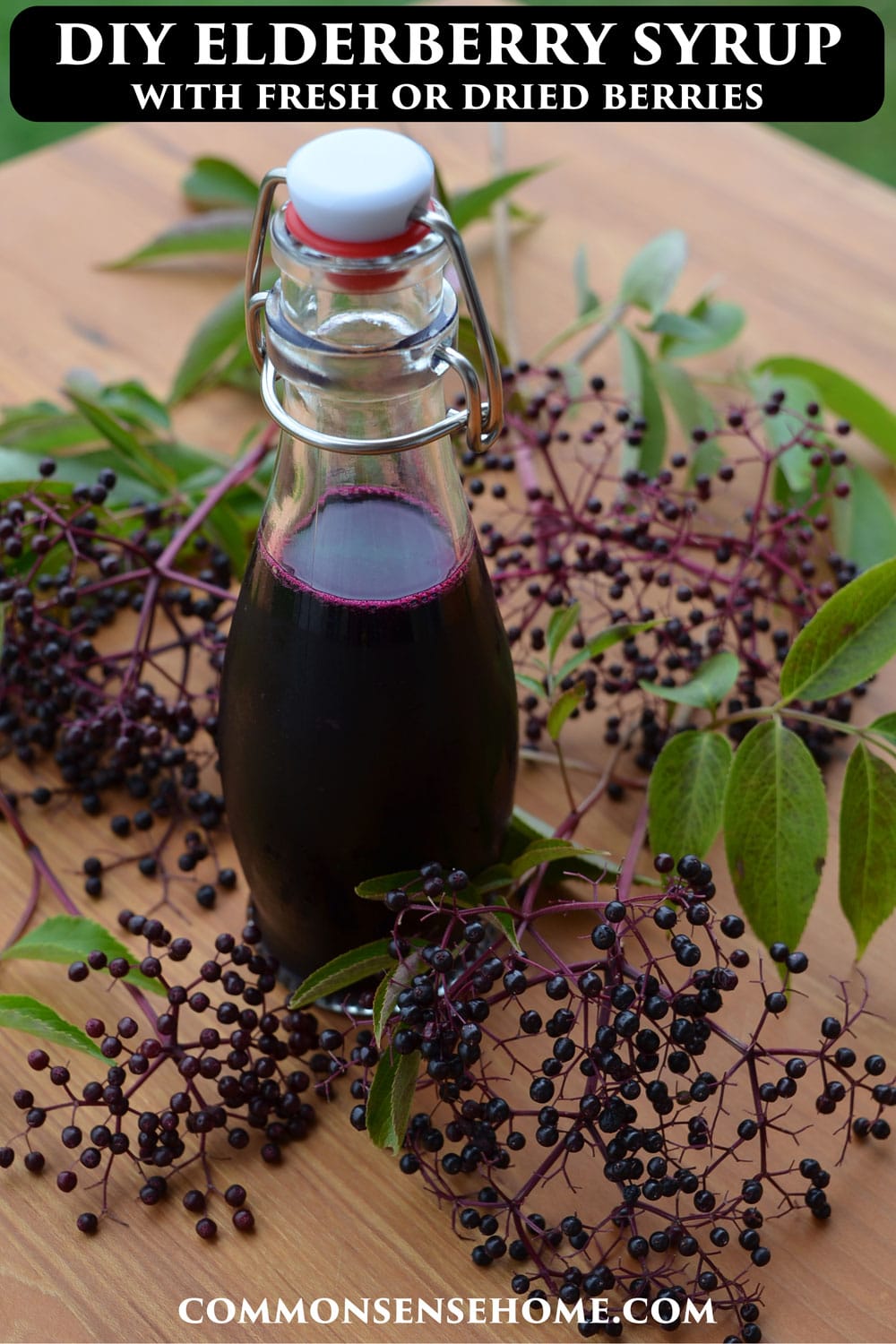
Is Elderberry Syrup Effective Against the Flu?
Yes! Scientific studies show that elderberry syrup helps fight the flu virus and beat flu symptoms. They include:
- Study of the efficacy of oral elderberry extract in the treatment of influenza A and B virus infections.
- The effect of Sambucol on the production of human cytokines: I. Inflammatory cytokines.
- Inhibition of several strains of influenza virus in vitro and reduction of symptoms by an elderberry extract (Sambucus nigra L.)
I’m very thankful to have a stash of elderberry syrup on hand for the coming winter months!
Can dried elderberries be reused to make two batches of syrup?
During cooking, the berries give up their healing compounds to the syrup. This means it’s best to use new berries each time you make a new batch.
More Elderberry Recipes
Our patch produces a bountiful harvest, so we make a lot of different recipes, including:
- Elderberry Jelly
- Easy Elderberry Jam
- Old-Fashioned Elderberry Wine
- Elderberry Tea
- Elderberry Gummies
How do you put this amazing fruit to use? Leave a comment and share your thoughts.
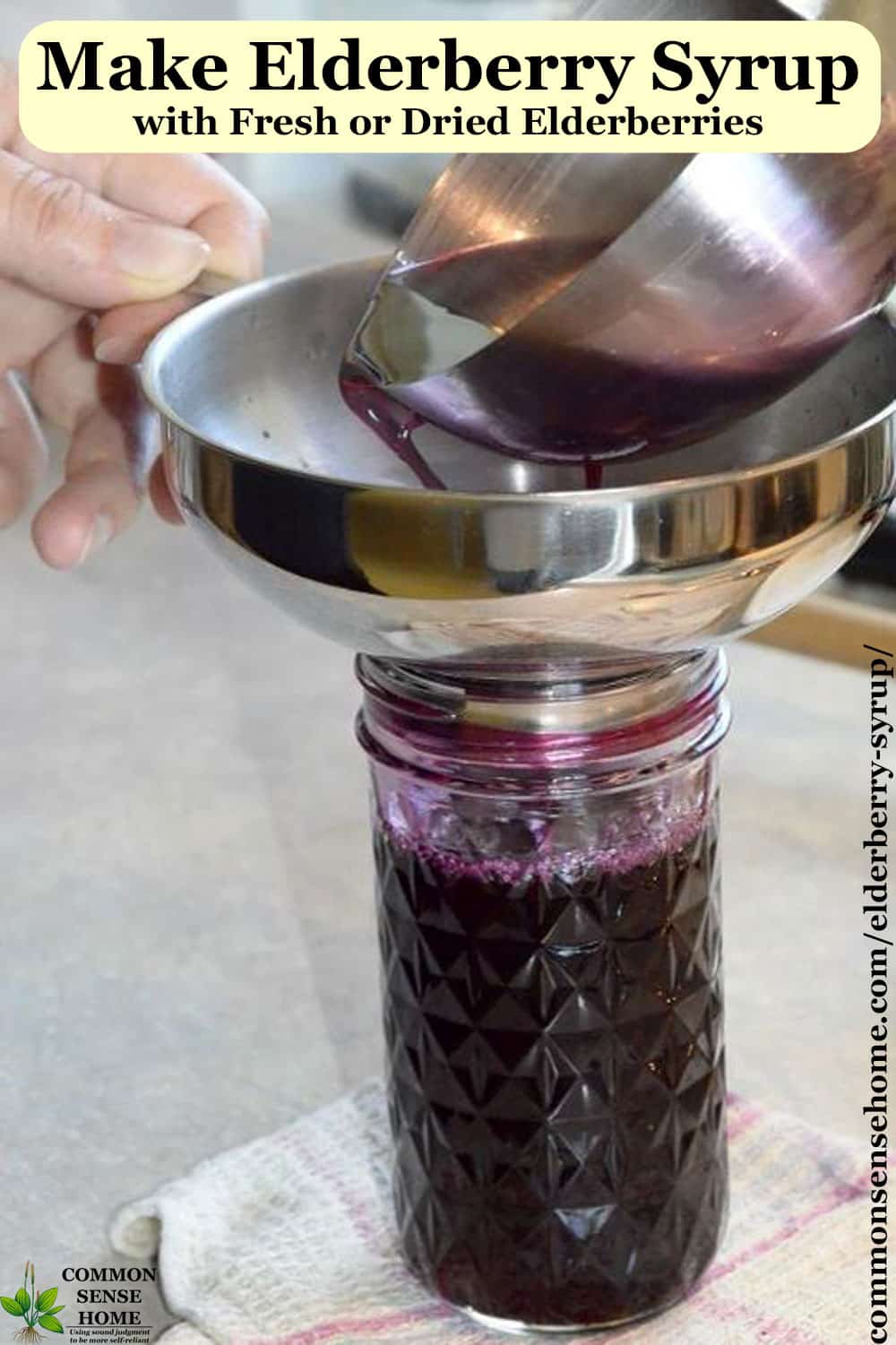

This article is written by Laurie Neverman. Laurie is a lifelong learner with a passion for natural remedies and holistic healing. She’s successfully improved her eyesight, cleared her psoriasis, and gotten off of prescription medication.
Last updated in 2023.


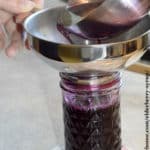
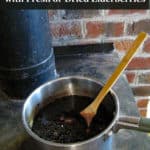
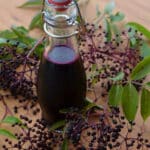
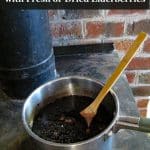
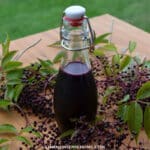
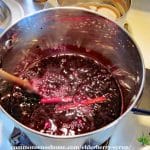
Great recipe!
How do you reconstitute dried elderberries to natural strength juice? I do not want to make syrup. I will make jelly with the juice. Thanks!
You can rehydrate the berries some by soaking them in water for 30 minutes (or more), and then press the liquid back out, but you’re not going to get a product that is equal to natural strength juice. If you want juice to make jelly, it would be better to simply buy some elderberry juice, or find somewhere to buy berries or forage berries.
I cannot believe that you would put honey in your recipes and simmer it. Anything over 110 degrees
destroys the wonderful healthful enzymes in honey. Always cool your product to 110 degrees before adding honey. Honey has too much to lose otherwise.s
The recipe that’s not canned calls for adding the honey after the berries have been simmered. The honey is not simmered.
The recipe that’s canned is necessarily heat processed, so the enzymes are already toast.
Hello,
I want to make the syrup with honey and it seems easy enough, However how do you make the juice? I am going to do 3 batches at a time and need 3 quarts of elderberry juice. So how do you make the need juice? Do you just boil down 3 quarts of the berries? Mine are frozen.
Thank you so much!
Hi Barbara.
To get the juice from the berries, remove the stems and cook until well softened, about 30 minutes or so, stirring as needed.
Place the berries in a jelly strainer or old flour sack towel or pillowcase (they will stain) and hang to let the juice drain out. I hang a towel from up upper kitchen cabinets. My mom used to hang hers from the back of a chair.
You can squeeze the towel to speed things up, but that will get more pulp in the juice. If you don’t mind the pulp, not a problem.
My husband purchased today,8 ounces of elderberry something, it was $23.
My husband and I are struggling to make ends meet yet want to be healthy and My 81 and 1/2 year old mama lives next door, Praise the Lord 🙂
This Elderberry concoction in a tiny jar with plastic to cover it from the lid is loaded with seeds.
Is that okay ?
The compounds in the seeds should break down with proper heating, but without knowing how the concoction was processed, I can’t say for sure. Is there any way to find out how long it was heated?
I’ve been making and giving away quart jars of elderberry syrup for awhile now. I buy the dried berries (I’m thinking of getting some trees to grow) and simmer 1 cup berries in 4 cups water about 45 minutes or until it reduces not quite by half. I mash the berries, strain the whole thing, add some honey to taste (not much) and let cool. Then I put it in the coldest part of my fridge to prevent any mold as it makes quite a lot. I work in a school and am always being coughed on. I almost never get sick anymore. The one time I did my symptoms were very mild. The last time I made it, I used 2 cups of berries and it didn’t reduce all that much and I got 3 quarts for about $8 worth of berries. Much less expensive than store-bought syrup.
I just ordered a bunch of dried berries to make syrup to get our family through the rest of flu season. We are dieing here. I noticed that you don’t include canning instructions for the dried berries. Can I just follow the instructions for the others to can the syrup I make from the dried berries?
The dried berry recipe makes a small batch by default, and as it’s currently written, the honey is still potentially raw. (Assuming you started with raw honey.)
If you want to make a larger batch and then can it like the others are canned, it should be okay.
Hi I have just opened a pack of dried elderberries to make some syrup and noticed they are mouldy. Are they safe to use?
I wouldn’t use them.
Thank you for your post! I usually use dried elderberries but a friend gave me fresh elderberries which i cooked in my instant pot with water and spices…is this sufficient cooking enough to start enjoying thw syrup after i add some honey?
I have been looking all over online and can only find dried elderberry recipes. Blessings!
The glycosides and alkaloids in the seeds break down with heat, but I don’t know exactly how quickly they break down at whatever temperature and pressure you used in your instant pot. (I haven’t been able to find many references on the topic.)
If you strain out the berries and simmer a little on the stove top to concentrate your brew, that should eliminate any glycosides and alkaloids that are left. (The drying process also helps to eliminate these compounds when you end up using dried berries.)
I see the recipes above call for either dried elderberries, or juice. What quantity of fresh elderberries would be used?
The amount of juice you get from your berries will depend on the berries and how you juice them. (Some berries will naturally be larger and more juicy than others.) We always start by juicing what berries we have available, and then making syrup or jelly based on the amount of juice on hand.
As I understand it, steam juicing will give a slightly higher yield, but I don’t have a steam juicer yet. You’ll probably need roughly 3-4 times the volume of berries to yield the desired amount of juice. For instance, to get one cup of juice, start with one quart of berries.
That makes perfect sense. Thank you.
You’re welcome.
I only found elderberry concentrated juice. If I’m making the syrup with the hone how much concentrated juice should I use?
That would depend on how concentrated your juice is. You could use it as is, but it would be very strong. Otherwise I’d add water to taste.
I’d like to suggest Ceylon cinnamon rather than the usual cinnamon, it’s far more medicinal. I have seen sticks of it before now.
Could you use the powder though? If so how much & what would the procedure be?
I usually buy organic Ceylon cinnamon sticks in bulk through our buying club. I’ve updated the post to clarify the preferred cinnamon and added links for purchase. If you wanted to use cinnamon powder, I’d probably use only a small amount if you were going to mix it in and leave it, because too much would potentially cause irritation. Maybe 1/8 teaspoon per batch?
Envious of everyone with access to fresh berries 🙂
I just discovered elderberries this fall, dried, and I’m the picky eater in the family and I love them. Will be investing in more can I see drinking this as my iced tea as well as medicinal purposes. I did learn that you can brew them twice so I can at least get good use for my money.
Just wondering if it makes a difference if you use clove powder,as that is what I have. Thanks
It’s you’re using powder, I would probably use less, as it would pack more tightly in the measuring spoon.
Thanks for your recipes and your comment about using your juicer! I just made the Elderberry Syrup with Honey & Cinnamon and the Syrup with Lemon and Cloves recipes from elderberry bushes I planted last summer. Both recipes were very tasty.
You’re welcome. Glad you enjoyed the recipes.
My brother planted some of them here in northern Utah and they did not do much for a few years. I planted mine and in three years they were 10 feet tall. The difference, we determined, was that I fertilize with ammonium sulfate 3-4 times a year. The summer he fertilized, they exploded. I only fertilize in the early spring now as they are about 18 feet tall. Apparently eelderberries are heavy feeders when they are growing.
Best wishes,
Gary Gorringe
Good to know.
I planted 4 bushes fall of 2014 and they have grown over 10 feet high already! I took the flowers from 2 of them, for cordial and drying, and am already seeing ripening berries on the other 2. Mine get full sun, and water when it rains in NE Kansas. I make the tincture because it lasts forever but am wondering if I can just add whiskey to the juice. Anyone know the poroportions of doing that?
Wine is shelf stable at around 10-13% alcohol by volume, so if you could do the math for the volumes you’re mixing, you should be able to get a shelf stable product. For example 1 cup zero percent alcohol (juice) + 1 cup 20% alcohol (40 proof) should equal 2 cups of roughly 10% alcohol.
Can anybody help me? I am making elderberry jelly and syrups but am wondering if there is any way to store plain elderberry juice? I would like to have it on hand when needed. Thanks to all for any advice!
We canned the straight juice in a water bath canner for 10 minutes with 1/4″ headspace.
Thank you so much for your quick answer. I’ve been biting my nails while this juice bag is dripping as to whether or not I had to immediately do something with it. I was up until almost 5 AM with these precious little commodities. Where they used to literally be almost everywhere in this area, all of the new subdivisions that replaced all of the farms has literally made elderberries a “thing of the past”. I’m hoping to be able to sprout quite a few of the seeds and get some elderberries planted in my back yard!
We’ve planted a number of them in a windbreak for our driveway, but they’re taking a while to get established.
Hi ,
I have been experimenting with Elderberries for several years and have made wine, and juices and I made syrup for pancakes, it was awesome …
Now I have an large batch of frozen berries in my freezer and am looking for some new recipes … ANYBODY have any ideas?
Strain some pulp and mix it with applesauce to make fruit leather?
Wow! As a novice to canning anything, it all sounds a little intimidating (toxic seeds, cyanide stems). I buy elderberry syrup now because I can’t (won’t) take the flu shot and try to prevent respiratory problems and viruses. Thought I would start growing my own bushes this year and maybe by the time I actually have quantity berry production I’ll feel more confident about making the syrup. Preferably the lower sugar one. Thanks for all you do to keep us newbies informed and inspired.
Don’t worry too much about the seeds and stems. The quantity of the compounds is pretty small, but it’s just suggested to avoid them to be on the safe side.
Hi, I worked in a small family facility in Montana yrs. ago, we made jams and jellies out of all the wild berries and also rose hips and wild rose petals. The easiest way we found to juice the elderberry was with a wine press. They are a bit expensive but work well. I am so happy I came across your sight, I am now living in Southeast Alaska and we have tons of red elderberries, I wasn’t sure if that’s what they were as all I had ever dealt with were blue. I had heard the reds were a bit toxic also but all of the natives here use the reds so I think I will have a go at it. Thanks for the wonderful sight.
If someone was going to do a lot of processing, a wine press would be a good investment. I have heard of the reds being used, but we don’t have them around here.
Hi Laurie,
I’ve seen recipes that say elderberry syrup (non-canned versions) should be used within 3-4 months. What goes “bad” in the syrup? Would adding lemon juice extend the shelf life? One recipe says to use within a 3 week period. I would imagine that using dried (everything) plus lemon juice would really help out. What’s your take?
The pH of elderberry can be right on the borderline in terms of “safe” pH for canning. Lower pH = reduced microorganism growth. Sugar binds up free water, which also inhibits bacteria growth. If you have a jar that’s being opened and used occasionally, you won’t have a set up for botulism growth, as it likes anaerobic conditions. Given enough time, even sugary preserves and syrups will grow mold and other interesting critters – it just tastes longer. Fruit does want to rot, after all. Herbs increase shelf life, as many are anti-bacterial. Using less sugar decreases shelf life (which is why low sugar jams will not last as long once open and should be refrigerated, while full sugar jams are generally shelf stable at room temp).
Thank you for your reply.
Would it be safe to say that increasing the acid level with lemon juice and a larger concentration of sugar (to the syrup) would extend the shelf life? I just wonder how added sugar would affect the health benefits we derive from taking elderberry?
Yes, more acid and more sugar would increase the shelf life to some extent. I’m sure there’s a point at which adding more of each would make no difference.
I don’t have any studies that would provide a definitive analysis of change in benefits versus a sugared or non-sugared product. I’m sure there would be some variation between batches, too. Honey has healing properties in its own right. Even sugar can draw inflammation from wounds – because of the aforementioned ability to bind with free water. A syrup also coats the throat, as opposed to a juice, which would just pass through.
I hope to ask one more concerning elderberry. Does canning the syrup affect the medicinal properties (high heat and all)? My thought is to acquire a few pounds of dried elderberry from Mountain Rose, can it, and share with relatives. If I can it, then the shelf life will be extended (presumably) and sit on the shelf till they need it (easier then making as needed around here).
Thanks for your info and Merry Christmas (happy holidays)
The only thing I can say for sure on that one is that I do can ours and it definitely still works when we need it. Fresh and low temp as needed would be ideal, but it’s awfully handy to have it prepped and ready when you need it, and canned is much safer to gift. I have shared our canned elderberry syrups with friends in the past.
PS – I’m just fine with Merry Christmas or any pleasant salutation of your choice. I was raised Catholic, but over the years have gathered an appreciation for many different beliefs.
Tonight I did your recipe of elderberry syrup with cinnamon and honey. Was my first time, but I processed it for the 10 minutes in the water bath and the jars sealed well. However, after talking with my husband I am super nervous about whether the acidity is enough to prevent against botulism 🙁 Have you had any spoilage from this recipe?
While it’s impossible to guarantee the pH of your specific elderberries, testing at the University of Missouri yielded elderberry pH levels in a range of 4.56 to 4.91, which would place it in the high acid to borderline high acid range. As a sugar, honey inhibits bacteria growth by tying up free water. It is used in wound care for inhibiting bacteria growth. Cinnamon is also naturally anti-bacterial. The elderberry juice itself is also antibacterial. So with the combination of the three ingredients, the syrup should be within safe canning guidelines.
if NOT canning the product but making the elderberry syrup from all dried ingredients, i.e. dried elderberry, cinnamon, cloves, ground ginger, water and local honey- can i keep it on the shelf Unrefrigerated?
i would prefer to not add any sugar, or lemon. would adding the local honey inhibit bacteria growth?
thank you for a great blog! love reading all the great questions.
The honey should inhibit bacteria growth, but the question is always, “How much?” The herbs used also have preservative properties. It should be shelf stable for a time, but I can’t say 100%, or for how long. Elderberries themselves are not overly acidic, so they don’t bring much to the preservative effort in that regard.
You are right to be concerned. The ‘magic’ number for canning is 4.6 …since there is no addition of acidity to this recipe, and since elderberries are NOT guaranteed to be below that threshold, there is no ‘by the book’ canner I know who would attempt to can this recipe. (Honey and sugar does nothing to protect against botulism.)
Actually, high sugar content does inhibit bacteria growth. From the University of Florida article “Preventing Foodborne Illness: Clostridium botulinum” (emphasis mine):
Sugar ties up free water, inhibiting bacteria growth.
Yes sugar does tie up water BUT if the juice is low in acid, it won’t be safe. You would need to add lemon juice.
in the 60’s wives of the chp, sheriff and game warden (my mother) collected purple elderberries from Bass Lake, Oakhurst clear over to Hornitos. Of couse they treaspassed but it was so rural at that time no one cared. Her jelly was tart and fabulously flavorfull and very dark in color. The freezing and juicing are worth trying cause it truley was a mess no matter how you did it. If you can make it at least once. It can make your reputation as home cook. Would be good with turkey and game.
How do you store the syrup once it’s open?
Keep in a sealed container in the refrigerator for up to two weeks.
I have to make a comment regarding the elderberries… I was happy to harvest my own elderberries this year but found out the hard way that the seeds are toxic. thought I’d have a small bowl of the berries which my body quickly rejected and continued to for the rest of the day- (both ends). Cooking and straining the seeds is for good reason… which I did after that. One of those things you might not know until it happens to you- some people more sensitive that others.
elderberries! OK – what IS the trick with them? I cooked down a large pot , mashed them to try to release the juice and get out the seeds – and there wasn’t much left after sieving them – it was mostly leftover pulp and little “juice”! Alot of work for just 1 jar of jam.,.,.,.,
Was going to put the next batch in the blender – but the seeds – are they a problem if you bust them up? I like to use the whole tomato this way (minus the bad spots), and it makes great sauce.
This might be my last year doing the elderberries, that was alot of work for very little produce. Birds love them tho, they wont go to waste.
As I understand it, it is indeed problematic to grind up the seeds, because of the toxins contained in them.
Barb,
I use steam juicer and steam the berries for maximum juice. It is still a lot of work, destemming, but there is no crushing or straining them to get their juice. I just cooked 4 quarts of berries (an ice cream pail) and got 2 quarts of juice.–enough for 2 batches of jelly.
I purchased mine on Amazon. Good luck!! Hope this helps!
As I understand it, the bluish purple elderberries (the ones used in the tutorial) are safe, and seeds are not toxic, but it is the red elderberries you need to be concerned about. I believe once they are cooked, you’re ok, but I would double check that somewhere. I have TONS of wild red elderberries growing on and around our property, but I’ve been hesitant to work with them due to seed toxicity & my lack of knowledge of how to properly process them. Like anything in the wild, you had better know exactly what you’re dealing with before you jump in with both feet!
Given that the commercial grower that I know processes all their products without seeds, and I’m generally not short on fruit, I’ll probably continue to skip the seeds, even if cooking is supposed to neutralize the cyanide forming compounds.
You might be interested in this red elderberry experiment at Wild Harvests blog.
If they are cooked, whole elderberries with seeds are no problem in moderation. Old fashioned cookbooks and foraging cookbooks are full of recipes for elderberry pie, cobbler, jam, dumplings and more. That said, too much will tend to have an effect on susceptible people. As one of my herbal guides puts it, “One slice of elderberry pie is delicious. Two slices of elderberry pie is delicious but may regulate your digestive system.” 😉 But again, they must be cooked first.
I suspect the effect is similar to garden huckleberries (the ones that are in the nightshade family). I can eat a few, but when I made them into pie, it didn’t sit well in my stomach. The guests who were visiting loved the pie – one ate two pieces with no ill effects.
this says red, is it the same for the dark blue-black ones?
Is what the same? As I understand it, heat is supposed to neutralize the problematic compounds in the dark elderberries, but some sensitive individuals may still be affected.
What about using dried elderberries from the natural foods store, do you have instructions on how to use dried if you can’t find locally?
Are you able to view the video? The video features a syrup made with dried elderberries.
Does anyone know where I can get Choke berry seedlings or seed? I want to start a patch
Baker Creek or rareseeds.com
Pick the green berrys off the vine. i know my mother in law said they were poison, she has been canning them for years now, (she is in her 70s and going full force) with no signs of slowing down
My mother made elderberry jelly for years, nothing better coming home from school and having a snack of homemade bread, butter and elderberry jelly. It is my favorite! My sister-in-law and I do homemade jelly every year, we enjoy the time out on our own picking berries, laughing and enjoying an atmosphere of beauty! We make all kinds of jellies, elderberry, wild grape, wild raspberry, and currant, blackberry and I have done gooseberry! There is Choke cherry and wild plums too… I have a daughter-in-law who is now interested in jelly making and canning! I am so excited, the talent of those have been lost through the years by many…good to see some of it coming back! I love jelly making and canning…love this sight! Thank You
Momma always said, “Many hands make light work.” It is good to see people coming back to the skills that were once taken for granted. I love going out and picking and harvesting when the crops are lush and ripe. It’s glorious. Thank you for your words of support.
I made elderberry jelly for years and years when I lived on the farm and nothing in the world taste as good as elderberry jelly. I did use a little bit of lemon juice in the jelly and it made it taste so great. Looking to buy some elderberries since I saw from your website they will grow in Georgia. The farm was in Wisconsin. Thank you so much for your site.
Elderberry Life sells seedlings. I’m thinking of planting some this spring. Wild foraging is fun, but it would be nice to have some closer to home, too.
Jim – did you see the recipe with honey using Pomona's pectin?
Avid elderberry wild crafter was able to pick 80 lb. this season l do farm market sales of the jelly and is very popular I also collect wild grapes and sell that jelly also very popular . have been trying to find recipe for making jelly using honey i found some information guess i will have to experiment loose jelly always goes good on ice or pancakes.
Pomona’s Universal Pectin is great for use with honey. They have a recipe book also that has tons of ideas and recipes.
In a pinch you can always use the dried ones from Mountain Rose Herbs or another quality supplier.
I don't know where to find them either but have been looking through nursery catalogs. Great job!
The best way to find the elderberry bushes is to look around swamps or other damp ground.
The best way to find elderberry bushes is to look for the huge flower heads (find a pic on the internet) on bushes (4-6 feet tall or so) in June when they are in bloom (in wet areas, common along the road). It is difficult to find the very dark berries at the end of August when they are ripe.
Bahahah, Sorry Laurie, I didnt realize I had your blog in my roll. Your my FB buddy. Lol! Sweet, see I knew you were there for a reason. 🙂
Hugs my friend. I am not on FB much but miss all my buds. Have a great week.
http://homeizcool101.blogspot.com/
As for finding the "safe" berries, there are lots of guides on the internet, but your best bet is to ask a local, especially older generation folks.
I love elderberries, last year I made a tincture out of the wild elderberries here in our area =)
O God Bless you darling. I am just getting in to elderberries. Thank you so much for posting this. I have question, How do you know which ones are good to eat and which is not. I am still learning about elderberries. My father is wanting to plant them on his property so in the future I wont have to run and buy them or buy the premade. I would love to learn more on them the Internet is great but doesnt help with the actual berry processing itself. I knew I followed you for a reason. Lol! Thank you again so much.
http://homeizcool101.blogspot.com/
Elderberries are easy to grow and , when the bunch of berries get deep purple they are ripe. You can use clippers to clip the clusters off the tree, there will be many,many bunches on each (I will call them bushes) tree. They will give you a lot of enjoyment also. When you are ready to harvest have yourself a large container. I have a 3 gallon stainless steel bowl and that is what I use when clipping them off. I had one pan almost full when my daughter Heidi and I removed the berries from the stems and then (we have a juicer) so we juiced the berries and got 3 1/2 quarts of puree’. This system is so much easier and less time consuming than cooking the berries and draining them. All your work is done for you then because you now have thicker puree’ instead of just juice you can add about 2 cups of water to thin it out. Then just follow the Homestyle Jelly recipe. It is delicious and your family will love it. You can use these berries to make the syrup and that is good on pancakes and french toast. But syrups of any berry or fruit is also good sprinkled on things like cheesecakes etc. Please enjoy.